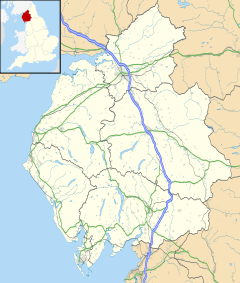Waitby facts for kids
Quick facts for kids Waitby |
|
|---|---|
 Waitby |
|
| Population | 60 (2001) |
| OS grid reference | NY7508 |
| Civil parish |
|
| Unitary authority |
|
| Shire county | |
| Region | |
| Country | England |
| Sovereign state | United Kingdom |
| Post town | KIRKBY STEPHEN |
| Postcode district | CA17 |
| Dialling code | 01768 |
| Police | Cumbria |
| Fire | Cumbria |
| Ambulance | North West |
| EU Parliament | North West England |
| UK Parliament |
|
Waitby is a small village located in the beautiful area of Westmorland and Furness in Cumbria, England. It's part of a larger area called a civil parish, which is a local government area. This parish includes Waitby village, the nearby village of Smardale, and tiny groups of houses known as hamlets like Riddlesay, Stripes, and Leases. These areas are mostly farmland and are about 200 to 300 meters (650-1000 feet) above sea level.
The southern part of the parish is higher, between 300 and 400 meters (1000-1300 feet), and is mostly open land with heather, not used for farming. Waitby is bordered by the Ravenstonedale parish to the south and Crosby Garrett parish to the west, where the Scandal Beck stream forms the boundary. To the north and east are the parishes of Soulby and Kirkby Stephen. In 2011, fewer than 100 people lived in the Waitby civil parish.
Small streams, called "becks" in this area, flow through Waitby. Waitby Beck starts from springs near the village and joins Sandwith Sike, which then flows into the larger River Eden. Other small becks like Hazel Gill and Choup Gill also flow into Scandal Beck.
Two important railway lines pass through the Waitby parish. The famous Settle & Carlisle line crosses the area. The old South Durham & Lancashire Union Railway also used to run here. Both lines cross Scandal Beck using impressive bridges called Smardale Viaduct and Smardalegill Viaduct.
Contents
What's in a Name?
The name Waitby comes from very old words! It was first known as Watebi around the year 1170. This name means "wet farmstead." It comes from two Old Norse words: vátr (meaning wet) and by (meaning farm, like the word "byre" for a cow shed). Some people also think the village might have been called Wadeby or Waldeby, and that its name could mean "Waldeve's dwelling" (Waldeve was a person's name).
Smardale Village
Waitby parish also includes the village of Smardale. You can find out more about Smardale in its own article!
Cool Places to See
There's a special nature reserve called Waitby Greenriggs. It's just east of Waitby, outside the parish, on the way to Kirkby Stephen. This reserve is located where two old railway lines, the South Durham & Lancashire Union Railway and the Eden Valley Railway, used to meet. The Cumbria Wildlife Trust bought this land in 1987 to protect its wildlife.
Waitby's History
Waitby Castle
Waitby has an ancient site called Waitby Castle. It's not a big, fancy castle like you might imagine, but a type of old fort built by the Romans or people living in Britain around that time. It sits on top of a small hill. You can still see the circular banks of earth that formed the walls of this fort, and even the faint outlines of some buildings that were once inside.
Waitby and Smardale School
A school for the children of Waitby and Smardale was started way back in 1630! It was a "free school," meaning children could attend without paying. A man named James Highmoor, who was a weaver from London but born in Kirkby Stephen, gave £100 to help keep the school running and pay a teacher. The school building was rebuilt in 1867 with money raised by the community.
Today, the building is simply called Waitby School. It's a special building because it's "grade II listed," which means it's historically important and protected. It has now been changed into a place where people can stay for holidays.
Waitby also has a local football team called Waitby FC!
Other Historic Buildings
Several other buildings in Waitby are also "grade II listed," meaning they are important historical structures. Leases farmhouse, built in the 18th or 19th century, and a nearby 19th-century barn and boundary stone are protected. Wharton House, an 18th-century building, and its old threshing barn in Waitby are also listed buildings.


